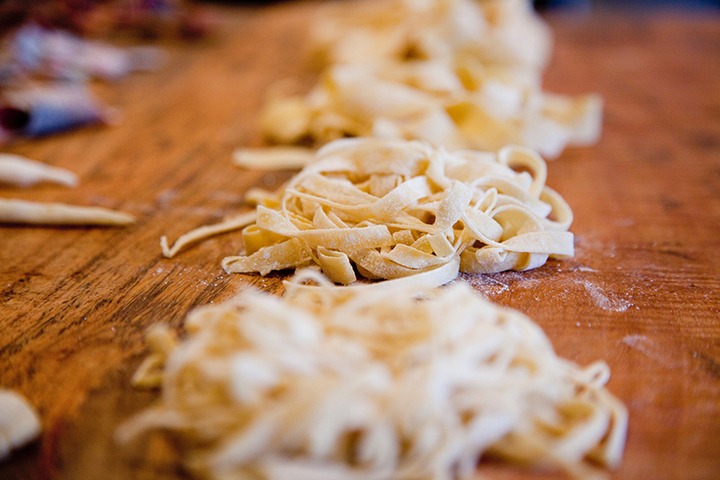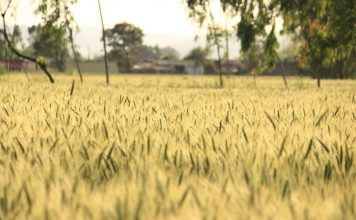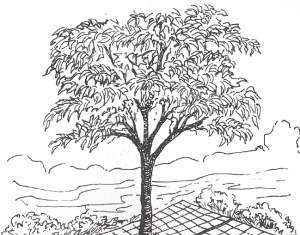 |
|
| Issue #105 • May/June, 2007 |
As any noodle lover knows, the world of noodles is a big one with almost every country having a traditional noodle deeply rooted in its history and culture.
Italy is known for its long pastas like spaghetti and linguini. Germany is noted for spatzle and Hungary for its pinched noodles or csipetke as my Hungarian-born husband fondly calls them in his native tongue. India is famed for a snacking noodle called Wai Wai, and nothing says China like chow meinjust to mention a few popular worldly picks.
Even though I love them all, when it comes to picking a noodle that’s a cut above the rest as far as good health goes, the humble soba noodle from Japan comes in a winner.
Soba is the Japanese word for the buckwheat plant which botanically speaking is a fruit and not a true member of the grain family like wheat, barley, oats, and other cereal grains. In Japanese, the word also refers to the popular soba noodle and flour from which it is made.
In the New World, when someone mentions soba you can bet your bottom dollar that they are referring to the tender, delightfully chewy noodle that is growing in popularity in North America at restaurants devoted solely to soba.
|
Because fast-growing buckwheat can shoot from seed to mature kernel in 75 days on even the poorest of soils and under the harshest growing conditions, for centuries it has held ground as a reliable, nourishing food plant of Japan with a remarkable reputation as being a lifesaver in times of famine.
In more recent years in the western world, word has been spreading that buckwheat is a super healthy food choiceone that is especially well suited for those who have grain allergies since studies have shown that allergic reactions to buckwheat flour are very rare.
Buckwheat is nutritious and offers a good source of protein, vitamins, amino acids, lipids, and minerals including potassium, magnesium, phosphate, and iron, and is rich in dietary fiber.
Ancient Japanese writings state that soba is beneficial at cleansing the liver, stomach, and intestines as well as helping to relieve pain caused by arthritis and rheumatism.
Buckwheat has been cultivated in Asia for more than 1,000 years. It was introduced to Europe in the Middle Ages and transplanted to the New World by settlers. There are various strains of buckwheat but the authentic Japanese buckwheat is the type most widely cultivated in North America.
Anyone who has eaten buckwheat honey will be familiar with the earthy flavor and tempting aroma of the buckwheat plant which is reflected in the flours. Buckwheat flour can be purchased in various forms from very light flour known as sarashina to numbers 1, 2, 3, and up to dark known as sanago and uchiko flours, as well as fine grade and coarse cracked groats.
Buckwheat flour has a naturally sweet, light flavor and pleasant, nutty aroma which gives the long, thin brownish soba noodle so much of its appealing character. For making soba noodles, I have had the best success using organic stone ground light buckwheat flour which is available at larger supermarkets, Asian grocery or health food stores. One of the oldest Japanese secrets for making a top quality soba noodle is to use the freshest flour available.
You can buy many different brands of commercially prepared soba noodles which are usually sold in dried forms at most stores that carry Asian foods, but absolutely nothing measures up to making your own soba noodles at home and serving them super fresh in the same manner as Japanese cooks have been doing for hundreds of years.
The rewards of making soba noodles are many. For one thing, they are economical, easy and downright fun to make. Another reason is that making soba noodles, the process being known in Japanese as…Te uchi which means “beating the buckwheat,” insures that you are feeding your family the freshest and best there is.
The term “beating the buckwheat” refers to the fact that buckwheat does not stretch or bind easily and must be “beaten” or worked well with the hands to coax it to take on a viscosity that has almost magical powers. As the flour is worked with the hands, the water soluble proteins break down and the dough begins to bind, a stage often referred to by soba experts as “blossoming of the dough.”
When it comes to making soba noodles, take comfort in knowing that even if the first couple of batches of noodles aren’t perfectly uniform in shape and size, they will still be totally edible and your effort and money will not have been wasted. Once you get the hang of rolling and cutting the noodles, they will be picture perfect and delicious every time.
Soba noodles are as much fun to eat as they are to make. To help the body cool down in hot weather, the noodles are traditionally served icy cold on a zaru or bamboo type plate or basket with chopsticks and accompanied by little individual bowls of fragrant dipping sauce which makes a refreshing meal in itself. Of course, soba shops around the world have developed hundreds of ways of garnishing the noodles with everything from grated daikon radish to tiny specks of nori (seaweed) confetti.
|
To warm the body during cold weather dining, soba noodles can be served in any rich broth or used in place of any other type of soup noodle. The most popular broth used by authentic cooks for serving with soba noodles is one that is traditionally made from a base of soy sauce, mirin, and a scant amount of sugar which is fermented for at least 2 to 3 days before using in order for flavors to mellow like wine.
Below you will find the ancient recipes for traditional base and stocks which you will, no doubt, eventually want to sample. But to help get you started in the world of soba dining, I have also included a couple of super easy, modern-day, instant versions that are almost as good.
So let’s soba…by making the noodles first.
Homemade soba noodles:
This recipe makes about 2½ pounds of noodles with 1¼ pounds of noodles serving 4. You can spread excess noodles on a chopping board or drape noodles over a clean bamboo or other type of stick to air dry. When all the moisture is gone, store noodles in an airtight container which will give them a long shelf life. They are very fragile and break easily so handle carefully. Or you can freeze fresh made noodles for future use by packaging in zip-lock bags, although I find soba noodles are always best when eaten fresh. I usually put the surplus noodles in a sealed container and set in the fridge where they keep very well for up to a week. Once you taste how good these noodles are, you will not have to worry about what to do if the batch is too big for one sitting. Do not cut the recipe in half as I have found that a smaller amount of dough is harder to work with as is larger batches of dough so don’t increase the recipe either.
5 cups of light buckwheat flour
2¾ cups unbleached wheat flour
2 cups hot water
In large mixing bowl, blend flours. While mixing the flour together in a circular motion with your hand, stir in 1¾ cups of hot water in a continuous manner stirring constantly to avoid lumps from forming.
Using hands, mix until all flour is moistened. Using both hands, grasp the damp flour between your finger tips, pressing the flour between your palms and letting it drop back into the bowl. Work the flour in this manner until it feels like little pebbles.
Grab a handful of flour with both hands and squeeze tightly. You will feel the flour starting to take on body. Break the handfuls of dough apart, let them drop back into the bowl and then form another two handfuls. Work the flour for about 2 or 3 minutes in the above fashion repeating until the flour begins to get sticky. This is what is called “tapping” or “blossoming” the dough.
Add the remaining water and continue working the dough by grabbing with your hands, rubbing and dropping it back into the bowl. You will notice the pebbles expanding.
Knead in a pumping fashion, exerting lots of pressure from the shoulder area. Old Japanese herbalists claim that making soba noodles is a therapeutic workout for tense muscles in shoulder, arms, wrists, and hands. Work the dough until it can be formed into one big smooth ball.
Continue kneading until smooth and elastic, rolling around inside of the bowl to rid the dough of hidden air pockets.
Divide the dough into 6 equal portions and form into balls. Place in another bowl and cover with a damp cloth.
Sprinkle a large work surface with buckwheat flour and roll out a ball of dough until it is about 1/8 inch thick, making length about twice as long as width.
Lay the sheet of dough on countertop that has been lightly sprinkled with buckwheat flour. Roll out remaining balls of dough, sprinkling each sheet lightly with buckwheat flour before layering on top of each other.
Transfer the layers to a cutting board and cut the layers in half, restacking neatly. Fold in half.
To cut noodles, place one hand on dough as a guide and using sharp knife, cut into thin noodles about 1/8 inch wide. Strive to work the knife in a smooth, continuous slice for uniform noodles.
When the noodles are sliced, separate gently with your hands. They are now ready for cooking.
To cook fresh soba noodles:
As with any pasta, use plenty of water for cooking. A general rule of thumb is to use 4 quarts of water per pound of noodles. Bring water to a rolling boil. Add noodles while stirring gently back and forth with a long wooden spoon. When the starch begins to dissolve, the water will turn milky. As the water reaches a second boil, it will start to foam and rise quickly to the top. Be ready to lower the heat to keep it from running over. Once heat is lowered, simmer for 1 minute. A properly cooked soba noodle should be tender, firm, and chewy. Set strainer over another large pot and pour noodles into strainer catching the cooking liquid known as soba yu. This liquid contains valuable nutrients and can be used in the broth or saved for another day’s soup. Empty the noodles from the strainer into a large bowl of cold water and rinse well. This step firms up the noodles and washes off excess starch. Rinse well. If you are serving the noodles cold, rinse in ice water, drain well and chill until serving time. If serving noodles hot, they can be reheated by dipping into hot water or broth for about a minute.
Cold soba noodles with instant dipping sauce:
1¼ pounds homemade soba noodles, cooked and cooled as directed above
2 cups soba yu or saved cooking water from noodles
½ cup (more or less to achieve desired strength and color) soy sauce
1 Tbsp. mirin
1 tsp. sugar
pinch of bonito flakes (fish flakes can be purchased at Oriental food or larger supermarkets. They can be omitted if you wish but I find that they add authentic flavor and tempting aroma to dipping sauces and broths.)
1 clove crushed garlic
pinch of grated ginger
Bring water to boil. Add remaining ingredients and simmer over low heat for 5 minutes, stirring gently to prevent sugar from burning. Taste and adjust seasoning. Cool.
To serve, divide noodles onto plates. Sprinkle with chopped green onions and serve with a little bowl of dipping sauce on the side. Use chopsticks for added fun and flare. Serves 4.
Note for brown baggers: A dish of cold soba noodles along with a small container of dipping sauce makes a wonderful, nutritious and delicious lunch for toting to school or office.
Lin’s soba noodles in instant broth:
Here is my all time favorite way to enjoy homemade soba noodles. This recipe is so versatile, no two bowls of soup ever have to be the same. This serves four with seconds depending on size of bowls. It’s a wonderful way to warm up in winter.
1¼ lbs. noodles
Broth:
6 cups water
4 dried Shiitake mushrooms, broken into small pieces
2 oz. bonito flakes
1 Tbsp. garlic powder
¾ cup soy sauce (approx.)
2 Tbsp. mirin
1Tbsp. sugar
freshly grated ginger (pinch)
2 Tbsp. sesame oil
1Tbsp. chili oil (optional)
Cook soba noodles as directed previously.
Measure the water (or use the soba yu or saved cooking water) into large soup pot. Add the mushrooms, bonito flakes, and garlic powder. Bring to a boil, reduce heat and simmer 3 minutes. Add the soy sauce. Stir in mirin and sugar. Simmer for 5 minutes stirring constantly. Add the ginger and simmer another minute. Stir in sesame oil and chili oil, if desired. Taste and adjust seasoning.
To serve: place reheated noodles in soup bowls and cover with broth. Garnish with finely sliced green onions if you wish.
Be creative and have fun with this versatile recipe. Sometimes I add tender chunks of leftover cooked chicken or other cooked meat. Other times I’ll add prawns, snow peas, water chestnuts, sweet peppers, sliced daikon, cubed tofu, sliced celery, or anything else my heart desires to the broth and simmer until just tender before serving over the reheated noodles.
Ancient fermented flavor base recipe:
… for dipping sauce and broth
Every household in Japan has its special trademark for a home fermented flavor base. Here is a basic recipe that was handed down to me by the same Japanese cook who helped me make my first batch of soba noodles many years ago. Although the above instant recipes are delicious and quite similar in taste, you may wish to try this traditional method for making dipping sauce and broth.
Fermented flavor base:
1 quart soy sauce
¾ cup mirin
1 scant cup sugar, approx. (Sugar is traditionally used to help activate the fermentation process but it can be omitted.)
Put soy sauce and mirin in heavy bottom kettle. I use cast iron to insure it does not burn. Heat over medium until a golden foam starts to form. Add the sugar and stir constantly with a wooden spoon to prevent sticking. The foam will subside when the sugar is added. Reheat again until foam covers the top of the surface. Remove from stove. Cover pot with a clothdo not use lid or plastic as condensation will form and water droplets can deter the base from working. Allow to ferment overnight. Pour into a clean, dry bottle and cork or cap tightly. Store in cool, dark place. Let mature at least 3 days before using.
Traditional Japanese broth:
6 cups water or soba yu (cooking liquid saved off soba noodles)
1 to 2 ounces bonita flakes
½ cup flavor base
|
Combine water and fish flakes, bring to a boil, reduce heat and simmer 10 minutes. Add flavor base to suit taste. For soup, serve over cooked and reheated soba noodles.
Dipping sauce for cold soba noodle:
Cut above recipe in half. Chill until icy cold before serving.
Note: I have given the measurements that I find are best suited for my personal taste. When adding soy sauce, mirin, and sugar to your dips and hot broths, or when using the fermented base, start with smaller amounts and work your way to desired strength. Some folks like a richer, darker dip or broth. Others like it lighter and milder. It is easy to adjust to suit your own taste to a tee. Don’t be afraid to experiment.






















